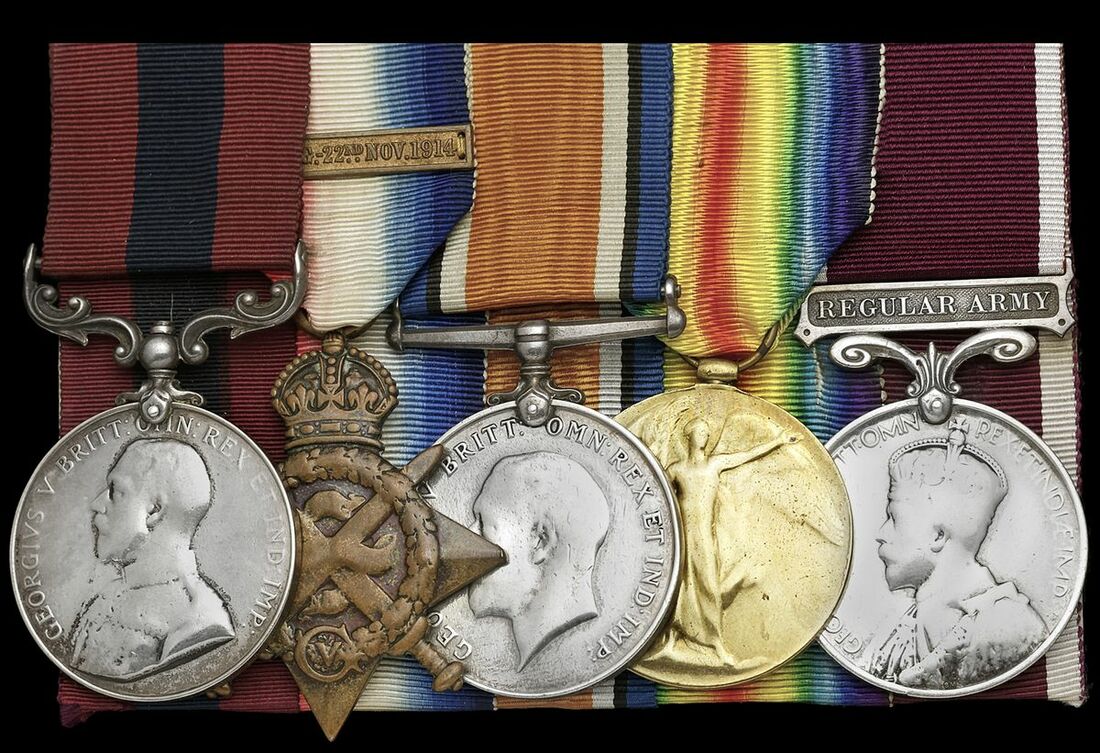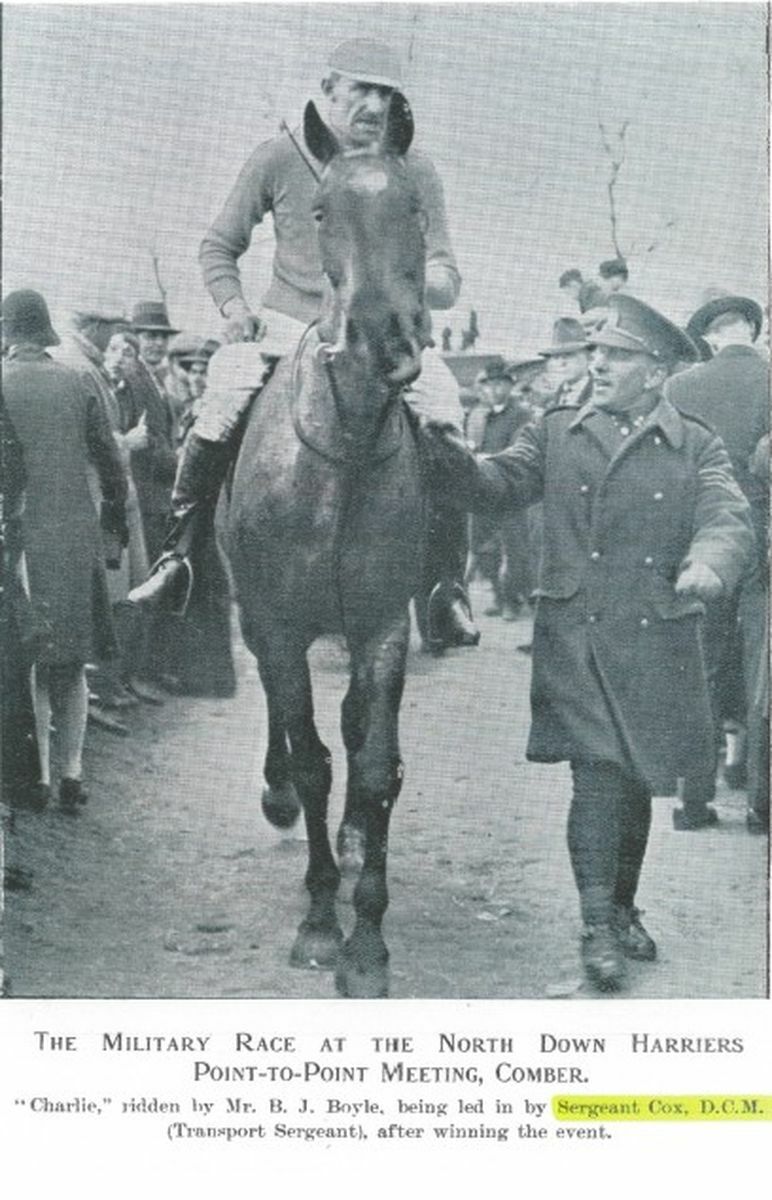Auction: 23003 - Orders, Decorations and Medals
Lot: 281
A fine '1914 Battle of La Bassee' D.C.M. group of five awarded to Driver Henry T. Cox, Army Service Corps, attached 7th British Field Ambulance, Lahore Division, Indian Corps, for his conspicuous gallantry near Neuve Chapelle on 29 October 1914, when, despite being exposed to enemy fire, he brought his horsed ambulance wagon up to the German front line on two occasions
He assisted in the evacuation of wounded men from the Royal West Kent Regiment and also a number of Indian soldiers who had sought refuge in an isolated farm building following their attack and withdrawal from Neuve Chapelle the previous day
Distinguished Conduct Medal G.V.R., (T.25142 Dvr: H. T. Cox A.S.C.); 1914 Star, clasp (T-25142 Dvr: H. T. Cox A.S.C.); British War and Victory Medals (T-25142 T.Sjt. H. T. Cox A.S.C.); Army L.S. & G.C. Medal, G.V.R., Regular Army (6686 SJT. H. T. Cox D.C.M., R.Innis.Fus.), the obverse heavily polished, overwise very fine (5)
D.C.M. London Gazette 18 February 1915. The citation followed on 1 April 1915:
'For conspicuous gallantry and devotion to duty at Neuve Chapelle, when he brought his wagon up on two occasions in front of the German lines and thereby enabled his section to remove our wounded, who would otherwise have been left in the enemy's hands.'
Henry T. Cox hailed from North Down, Ireland and enlisted for service with the Army Service Corps circa April 1907. On the outbreak of the Great War, Cox was one of many Drivers who were attached to the Royal Army Medical Corps to fulfil the Corps' role of supplying drivers and horse drawn ambulance wagons. Cox was attached to the 7th British Field Ambulance, which had itself been assigned to the Lahore Division, Indian Corps, as one of the divisional medical support units. His Medal Index Card confirms that he entered the France and Flanders theatre of war on 15 September 1914.
The ambulance transport allotted to the field ambulances with the Indian Corps consisted of six horsed ambulance wagons only for each ambulance. Motor ambulance cars were not given until 1915.
Cox was awarded the Distinguished Conduct Medal for his conspicuous gallantry on 29 October 1914, at Neuve Chapelle, when he brought his horsed ambulance wagon close to the German front line on two occasions under a heavy fire, and assisted in the evacuation of wounded men from the Royal West Kent Regiment, and also a number of Indian soldiers who had sought refuge in an isolated farm building following their attack and withdrawal from Neuve Chapelle the previous day.
The following report by Major T. E. Fielding was entered into the 7th F. A. War Diary for 29th October 1914:
'At 4pm I received a message from the D.A.D.M.S 3RD Division to bring all bearers and ambulance wagons to Divisional Headquarters with a view to going to NEUVE CHAPELLE to clear that village of wounded which had been left behind after an encounter with the enemy during the night....I left all the RAMC personnel and transport at this point, under the command of Captain McQueen and went forward to Brigade HQ at Richebourg to learn the situation and receive instructions.
Brig-Gen McCracken gave me verbal orders as to the road to take, the furthest point forward for the ambulance wagons and instructed me to get into communication with the O.C 1st Bedfords (Major Allason), and having obtained all available information from him, to use my own discretion as to further action. In conclusion, Gen McCracken told me I was not to expose my command to unnecessary risk of loss...The personnel with Lieut Smith and myself proceeded along the main road running SE from PONT LOGY until we came into touch with the CHESHIRE REGT.
As we passed the dividing line between the CHESHIRES and the BEDFORDS, firing broke out chiefly from our own trenches, but, in a few moments, this fire was returned by the enemy and it became necessary to take cover. For about ¾ hour, we were compelled to remain stationary, but, after that time, as the firing had practically ceased, we proceeded on our way and I found the BEDFORD REGT and saw Major Allason.
He told me that NEUVE CHAPELLE was occupied by Germans who had been firing on our own troops during the evening, and that it was inadvisable to send bearers into the village...I decided that it was impossible to take bearers into NEUVE CHAPELLE without running the risk of incurring serious losses, and I accordingly made the following arrangements...an officer of the R.W.KENT REGT lent me a guide to show me where some of his own wounded were and I collected these as well as some Indians who had been left in a farmhouse on the NEUVE CHAPELLE road.
Altogether we picked 16 wounded including 4 Indians. These were taken by hand carriage to the ambulance wagons...As we retired, the firing began again and we soon found we were still within range, for two wagons were hit, although neither men nor horses were injured'.
Cox was later allocated the new regimental number ET/48093, the prefix confirming that he was still employed in the Horse Transport Branch. He subsequently transferred into the Royal Inniskilling Fusiliers and appointed Transport Serjeant. In this role he received the Army Long Service & Good Conduct Medal in 1931 which was presented by Lieutenant General A. G. Wauchope, GOC Northern Ireland District, on the 18 September 1931.
Serjeant Henry Cox was discharged the service in 1933, having served over 23 years with the Colours. He was notably involved in horse racing in his native Ireland, being pictured leading the winning horse in a point-to-point race at Comber, North Down after the war.
Subject to 20% VAT on Buyer’s Premium. For more information please view Terms and Conditions for Buyers.
Sold for
£850
Starting price
£800







